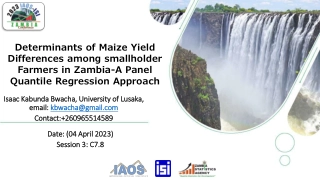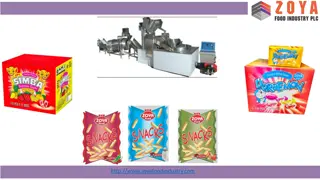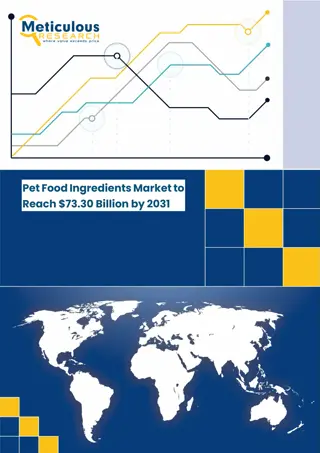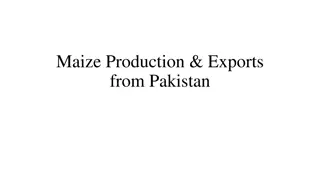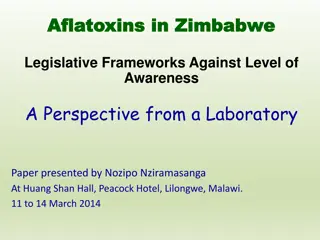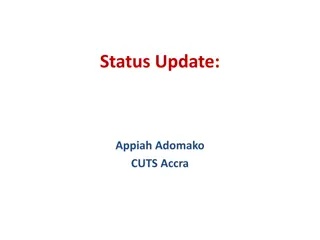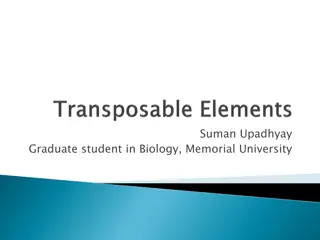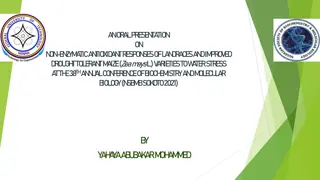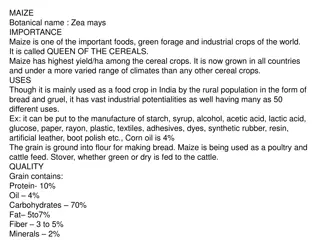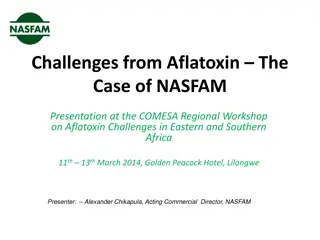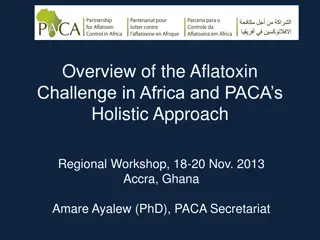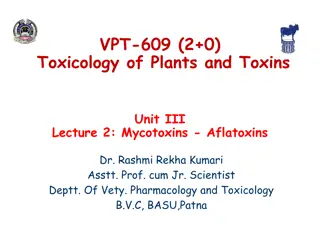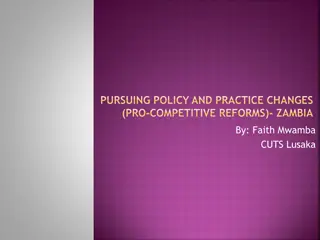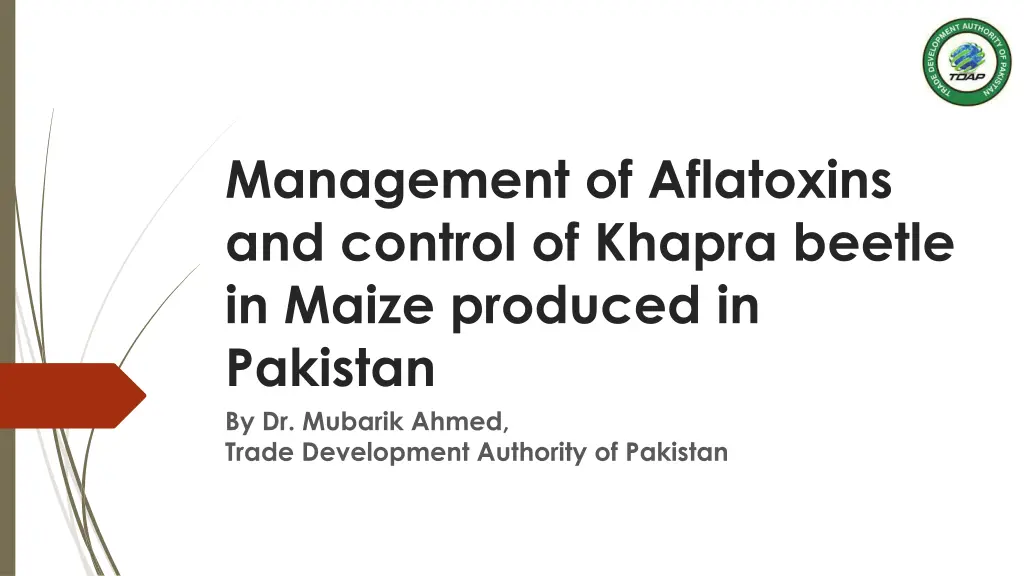
Managing Aflatoxins and Khapra Beetle in Maize Production - Pakistan Insights
Explore the challenges and opportunities in maize production in Pakistan, focusing on managing aflatoxins and Khapra beetle infestations. Learn about top maize exporters, existing markets, and major safety concerns affecting exports.
Download Presentation

Please find below an Image/Link to download the presentation.
The content on the website is provided AS IS for your information and personal use only. It may not be sold, licensed, or shared on other websites without obtaining consent from the author. If you encounter any issues during the download, it is possible that the publisher has removed the file from their server.
You are allowed to download the files provided on this website for personal or commercial use, subject to the condition that they are used lawfully. All files are the property of their respective owners.
The content on the website is provided AS IS for your information and personal use only. It may not be sold, licensed, or shared on other websites without obtaining consent from the author.
E N D
Presentation Transcript
Management of Aflatoxins and control of Khapra beetle in Maize produced in Pakistan By Dr. Mubarik Ahmed, Trade Development Authority of Pakistan
Introduction Maize is the 3rdimportant food grain crop of Pakistan with estimated production of 9.5 million tons in 2024-25. This is less than production of 10.634 million tons during 2023-24. Out of the maize production in 2023-24 about 9.739 million tons was produced in Punjab and 0.886 million tons in KPK. The contribution of maize in agriculture value added product is 3 percent and 0.7 percent in GDP.
Top Exporters of Maize in the World (Value-Billion USD, Quantity-Million Tons) 2020 2021 2022 Exporters % Share in World exports Value Quantity Value Quantity Value Quantity 36.70 51.90 Major Export Markets World United States of America 62.87 9.58 51.88 19.02 69.72 19.03 58.60 30.3 China, Mexico, Japan Brazil 5.85 34.43 4.19 20.43 12.26 43.39 19.50 Iran, Spain, Japan Argentina 6.05 36.88 9.06 39.95 8.61 33.01 13.70 Viet Nam, Korea, Peru Ukraine 4.88 27.92 5.89 24.68 5.99 25.18 9.50 China, Romania, Spain Spain, Netherlands, Germany France 1.72 4.55 1.94 4.30 2.37 5.16 3.80 Romania 1.23 5.71 1.94 7.06 1.99 5.54 3.20 Spain, Italy, Netherlands Poland 0.32 1.49 0.63 2.29 1.30 3.88 2.10 Germany, Netherlands, UK Taipei, Chinese, Japan, Viet Nam South Africa 0.56 2.59 0.81 3.33 1.21 3.92 1.90 India 0.39 1.77 0.94 3.62 1.12 3.49 1.80 Bangladesh VietNam Nepal Russian Federation 0.40 2.29 0.69 2.94 0.85 2.52 1.30 Turkiye, Iran, Korea
Top Existing Markets of Maize (Value-USD, Quantity-MT) 2020-21 2021-22 2022-23 2023-24 Quantity 324.029 164.641 50.802 45.718 15.526 13.430 6.833 5.860 3.395 3.363 3.147 2.208 2.120 Country Grand Total Viet Nam Malaysia Sri Lanka Philippines Oman Bangladesh Yemen Qatar United Arab Emirates Bahrain/Kingdom Of Bahrain Afghanistan Hong Kong Value Quantity Value 109,237 54,139 20,039 Quantity Value 775,360 441,514 204,504 8,831 - 75,875 - 2 8,664 8,122 8,730 3,279 6,288 Quantity Value 630,389 256,034 126,273 36,469 500 47,013 - 4 12,755 7,317 21,174 25,199 10,896 23.195 11.802 4.413 244.570 144.251 61.397 3.011 190.455 80.456 36.929 13.042 0.173 14.993 1,421,637 723,298 223,532 186,077 61,023 55,923 27,073 24,239 13,137 18,940 11,746 35,770 8,653 4.313 0.235 15,469 1,235 22.620 0.001 2.785 2.350 2.589 0.260 1.999 0.003 4.315 1.920 7.636 1.590 3.639 0.105 0.841 0.012 0.610 0.277 545 5,569 50 8,708 1,097
Major challenges in exports on account of food safety 1. 2. 3. Mycotoxins in maize and food preparations Khapra beetle infestation in maize Pesticide Residues in maize and food preparations (In significant) Microbiological contamination (In significant) 4.
Non-Compliance of agro products Produce 2023 2024 2025 Rice in EU due to Pesticide Residues 36 68 16 collective PR & A Rice in EU due to Aflatoxins 13 20 Chilies in EU due to Pesticide Residues 6 - Chilies In EU due to Aflatoxin 23 Maize Collectively on account of aflatoxin and Khapra infestation 80
Understanding of Aflatoxins
WHAT ARE AFLATOXINS? Aflatoxins are naturally occuring metabolites synthesized by two types of fungi Asparigus flavus and Aspargillus parasiticus Aflatoxins contaminate dietry staples including maize, rice, ground nuts, chillies, dry fruits, animal feed, milk, etc They are more abundant in tropical regions with high temperatures and humidity viz Sub-Saharan Africa and South East Asia
WHY ARE AFLATOXINS IMPORTANT Aflatoxins are proven to be mutagens, carcinogens and teratogens They produce disease called Aflatoxicosis Aflatoxin B-1 produces cancer and affect liver by producing liver cirrhosis, necrosis and carcinoma and by suppressing by the immune system
TYPES OF AFLATOXINS There are 4 types of aflatoxins found in cereals 1. B1 (AFB1) 2. B2 ( AFB2) 3. G1 (AFG1) 4. G2 (AFG2)
Pre and Post Harvest Factors that Contribute to Aflatoxins High temperature High humidity High moisture content
Permissible limits for Aflatoxins Different contries have set different limits of tolerance COUNTRY LIMIT India Pakistan USA Australia China Egypt Japan Russia European Union (processed) European Union (unprocessed) 30 ppb 30 ppb 20 ppb 15 ppb 20 ppb 10 ppb (5 B1) 10 ppb 5 ppb B1 4 ppb ( 2 B1) 10 ppb (5 B1)
Key to Aflatoxins Management Harvesting of mature crop Immediate thrashing after harvest Immediate and appropriate drying after harvest Cooling right after drying before bagging Storage in well ventilated and clean stores Proper periodic aeration in case of silo storage
Farm Level Use of disease free and healthy seed Implementation of GAP, GDP, GSP using suitable pesticides for the control of pest and diseases Proper drying using suitable drying surfaces Measure to control mixing of damaged and undamaged crop Development of rapid and cheap procedures for determining aflatoxin by the farmers Technical support to the farmers
Market Level Using suitable, ventilated stores for storage Reorganisation of central market structure to eliminate the mixing of fresh and old crop Developing a system to assess aflatoxin Training and resource development for operators working in the marketing channel Provision of support to farmers on quality level Implementation of grading standards based on scientific lines
Public Sector Investment and support to the public sector organisations for undertaking research on pre and post harvest problems Development of legislature framework for preventing the marketing of substandard products Organising training of stakeholders through farmer field schools and other dissemination procedures Development of reference laboratories for determining aflatoxins
How to check Aflatoxin in Maize 1. Aflatoxins can be checked by using one of the following procedure from the DPP approved laboratories in Pakistan 1. TLC method 2. Elisa testing 3. HPLC/LCMS testing 2. The approved laboratories are: 1. HEJ Institute of Chemistry, Karachi 2. PCSIR labs Lahore and Karachi 3. NIBGE, Faisalabad 4. MNS University of Agriculture, Multan 5. NARC, Islamabad
What is Khapra Beetle Khapra beetle (Trogoderma granarium) is an insect pest that is known to infest more than 90 commodities The primary host is wheat but it also damages Barley, Oats, Rye, Maize, Rice, Flour, Malt, Noodles, Chilies, Dry Fruits, Oilseeds etc. Khapra is a storage pest and also infest the packaging material. The adults are short lived and damage is caused by larvae. The insect can survive up to 9 months without any food and live in diapause Khapra is rated as one of the most destructive insect and is considered a quarantine pest. Pakistan in the past has faced bans on the export of rice by Russia and Mexico due to presence of this pest. Our Maize consignments (more than 65) have been intercepted by Vietnam and Malaysia last year and both the countries have sent alert notifications.
Sources of infestation The prime source of infestation are: 1. Use of old jute bags 2. Infested godown 3. Transporting vehicle 4. Docks 5. Improper fumigation
Why is khapra a quarantine pest Khapra is a very difficult insect to kill It is very destructive for stored products It can feed on several commodities It can live for 9 months without food It can survive at variable temperatures It closes its breathing tubes during fumigation It enters In diapause under un-favorable conditions
Difficulties in control of Khapra Many countries around the world has spent billions of dollars to eradicate khapra from their territories and are conscious to prevent its re- introduction
Rate of Propagation of Grain Pests Rate of propagation of the five important species of stored grain insect pests under ideal condition of temperature and humidity. Averarge number of eggs per female Average time takes to complete one generation (days) 26-28 Progeny of one pair in time (months) Insect Species (1) (2) (3) Angoumois Grain moth (sitotroga cerealella) 100 50 2,500 125,000 Khapra Beetle (Trogoderma granarium) 102 24-30 51 2,602 132,651 Rice Weevil (Sitophilus Oryzae) 200 28-30 100 5,000 250,500 It is assumed that egg viability is only fifty (50) per cent in each species and that sex ratio is 1:1 in each case Lasser Grain Borer (Rhizopertha dominica) 400 24-30 200 20,000 2,000 million Red Flour Beetle (Tribolium Castaneium) 450 26-30 225 25,312 2.8476 millon
Five Principles to keep maize free from khapra during storage Keep grain cool and dry. Keep storage biologically clean. Protect from pests. Inspect regularly. Undertake control measures in case infestation is detected.
The Biological Feedback Mechanism The impact of Respiration Temperature Respiration Bacteria Fungi Rel. Humidity moisture Cont. Insects The impact of Bacteria & Fungi Respiration Temperature Bacteria Fungi Rel. Humidity moisture Cont. Insects The impact of Insects Respiration Temperature Bacteria Fungi Rel. Humidity moisture Cont. Insects
Practical Application of Pesticides to Control Pests in Stored Products Pesticides are applied in food storage and processing premises or to grain with the following objectives in mind: 1. Prevention - to ensure that an empty structure in which is intended to keep food is free of pests. 2. Protection - to ensure the safekeeping of food stored in a warehouses. 3. Correction - to combat infestations which have developed.
What is a Fumigant? A fumigant is a chemical which exists in the required temperature and pressure in sufficient concentration to be lethal to a pest providing the exposure to that chemical conc. Lasts for an adequate period of time. All fumigants are respiratory poisons. All fumigants kill all stages of an insect egg larvae pupae adult
Types of Fumigants 1.Phosphine (dosage 3-5 g per cubic meter) 2.Methyl Bromide (dosage 60-80 g per cubic meter)
Properties Of Common Fumigants Phosphine Methyl Bromide Carbon dioxide Hydrogen Cyanide Formula PH3 CH3Br Co2 HCN Molecular weight 34 95 44 27 Boiling Point -87.0 3.6 -78.5 25.7 Specific gravity (gas) (air=1.0) Vapour Pressure at 30C (atm) Conversion factor g/m3 to ppm (30oC, 1 atm) 1.2 3.3 2.0 0.9 42 2.5 71 1.2 730 260 560 890 Flammability Limits in air (v.v) >1.7% 13.5-14.5% Nonfla mmabl e 0.76 6-46% Solubility in water (v/v) 0.2 3.4 Highly soluble Specific gravity at 30OC, (Liquid, kg/L) - 1.7 0.93 0.69
Pre-Requisites of Fumigation Air Tight Enclosure Application and Retention of Lethal Dose (Concentration x Time)
Impact of Godown Leakiness on Gas Retention If the Godown Leakiness is 50% then 1000 ppm dose after 24 hours will only be 500 ppm and after next 24 hours 250 ppm. Thus, on the 4th day of Fumigation, the Lethal Concentration will not be there.
Minimum Duration of Fumigations with Phosphine Temperature oC Duration of fumigation, days after application of fumigant Do not use phosphine 14 12 10 10 >12o 12-20 22-25 26-30 <30 Do not attempt to fumigate for less than the minimum exposure period recommended. Where possible give the maximum possible exposure period. If in doubt, fumigate for 15 days. Recommendations for minimum exposure periods issued by manufacturers of phosphine formulations are often too short for full control to be achieved in many instances.
Usage of Methyl Bromide Situations Considerations a) Stacks under gas proof sheets - Piping layout and Jets. - Walls or channels. - Sheeting and sealing. - Adequate distribution. - Retention of gas and sealing. - Correct loading. - Dosing and circulation. - Aeration. - Forced circulation. - Leakage. - Adequate distribution. - Retention of gas in treated areas. - Hazards to crew. - Delay and costs. - Vaporization of fumigant. - Residues/ b) Space or in-store fumigation c) Chamber-type fumigation i) Atmospheric fumigation. ii) Fumigation d) Silos e) Ships f) Flour and other finely divided commodities.
Options for Godown Fumigation Dosage Rate Application Type Level of Resistance Exposure Period Gas Retention of Godowns 0-X% SD Wind speed X -Y changes X-Y% MD Y+ = No. High Normal Low Single Multiple Susc. Resistant 5, 6 ,7,8,9,10 + Days

